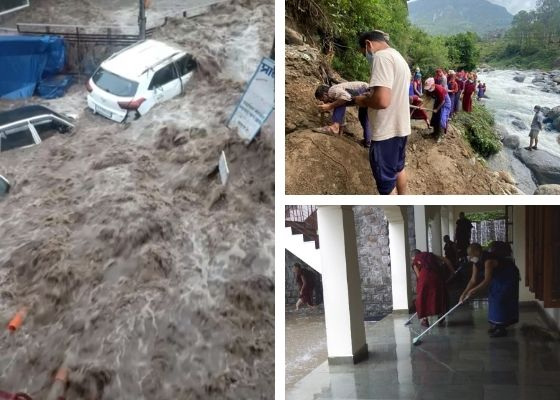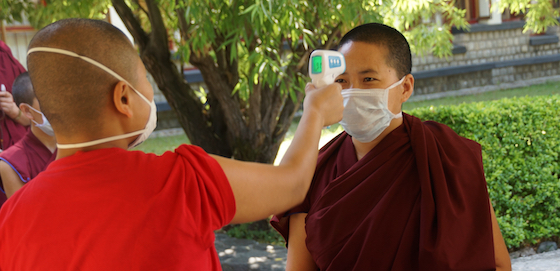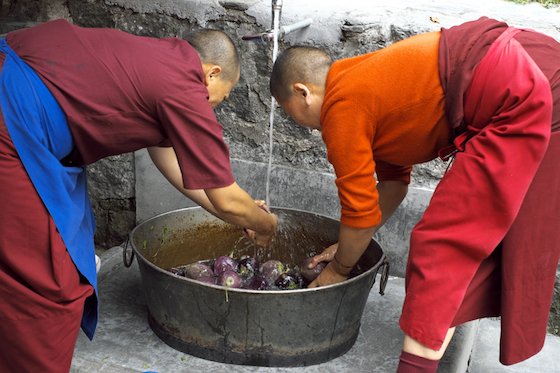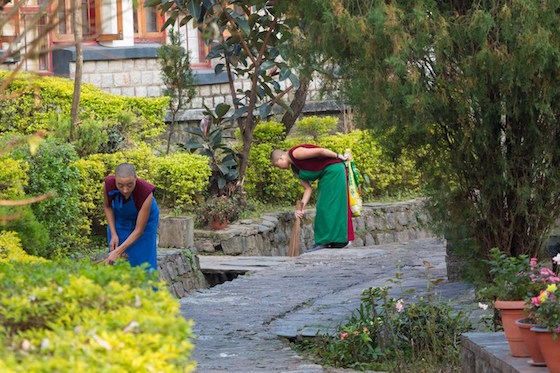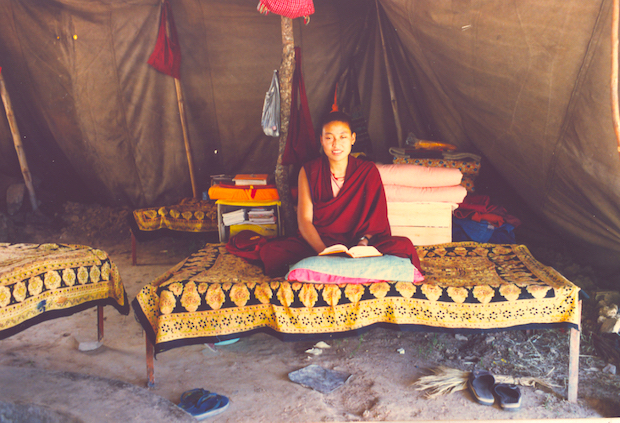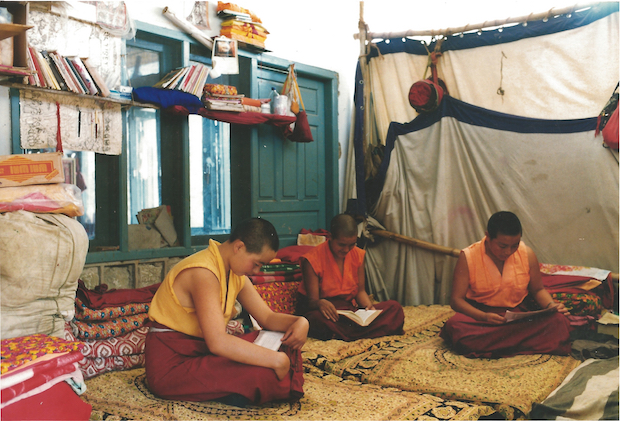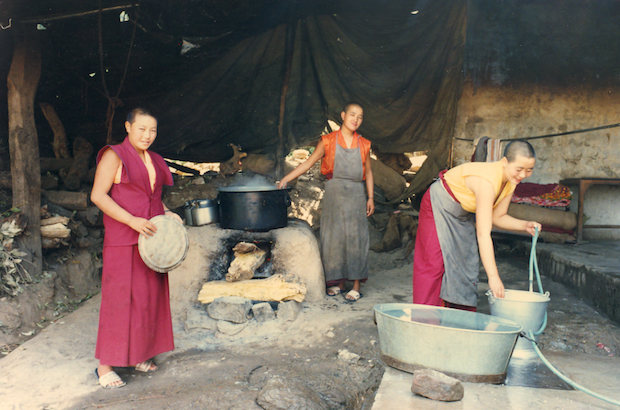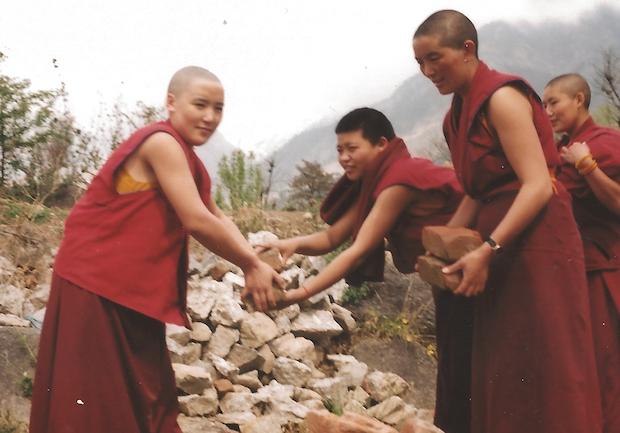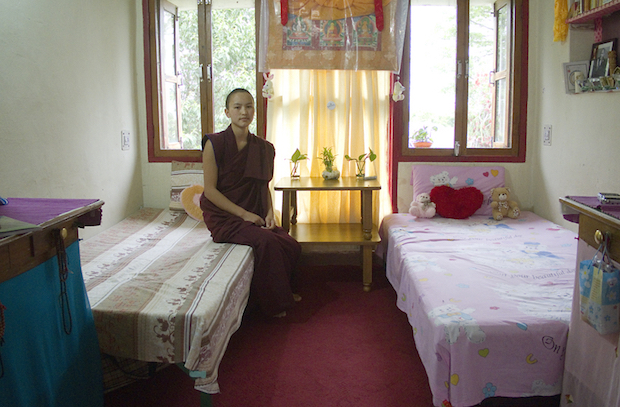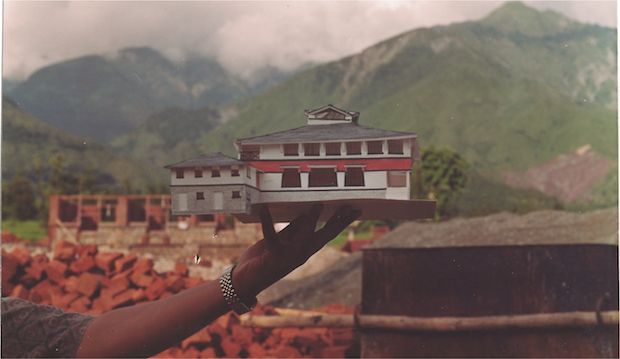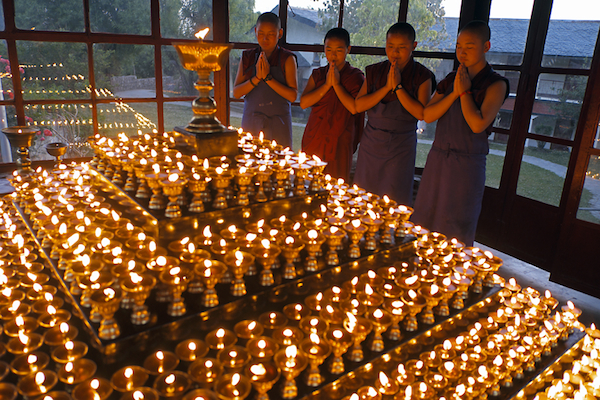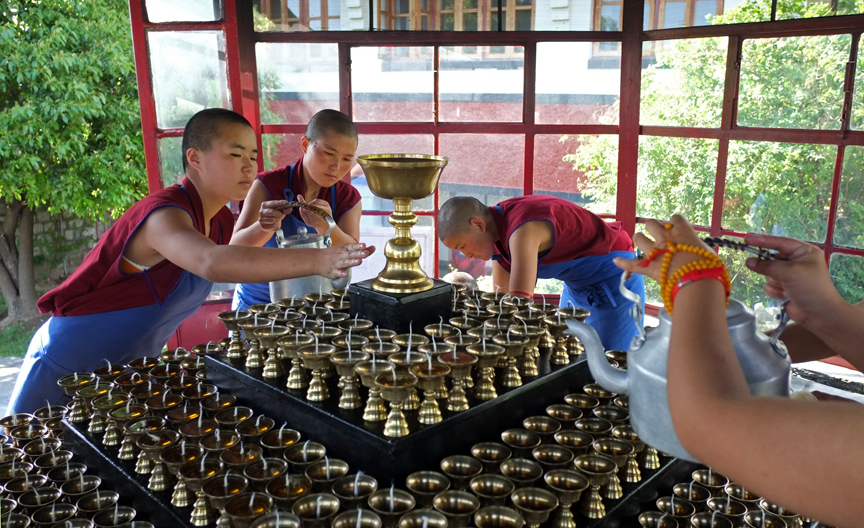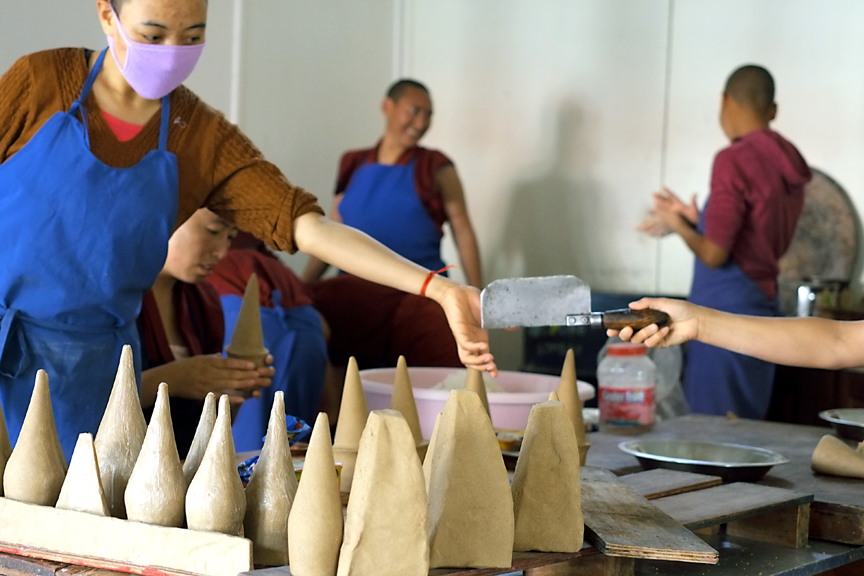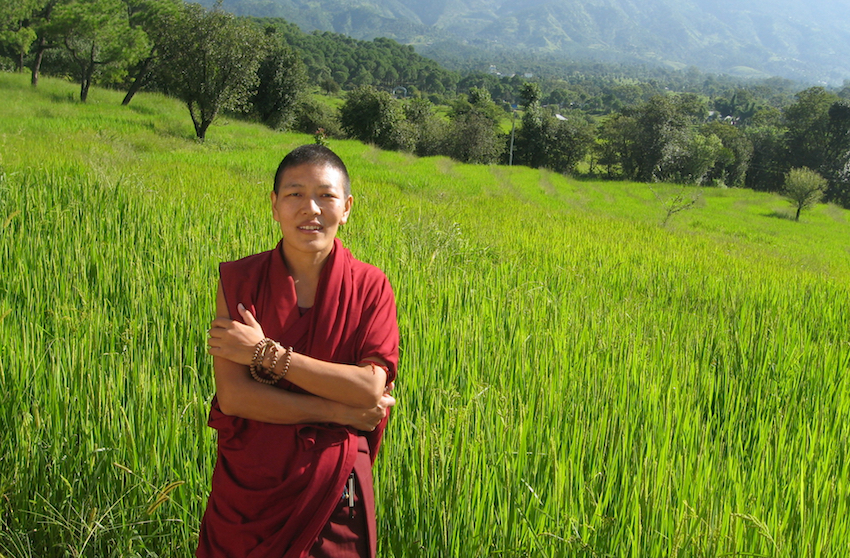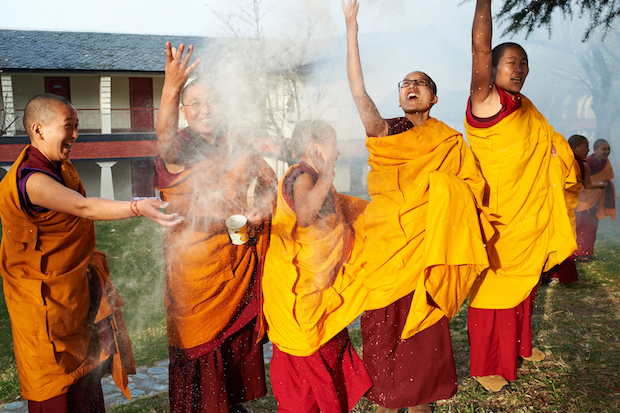Here is the latest news on the coronavirus lockdown at the Tibetan nunneries and how the nuns in India are coping.
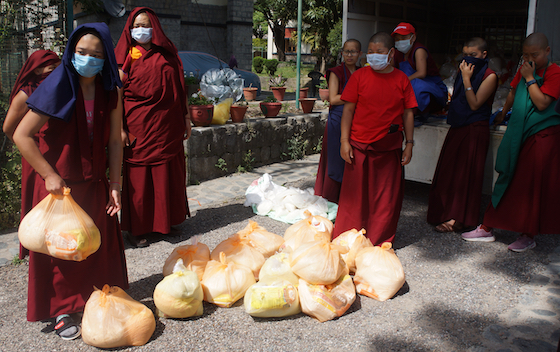
Compassion in action. Tibetan Buddhist nuns from Dolma Ling Nunnery and Institute share their rations with 100 of the poorest village families near the nunnery. Photo courtesy of the Nuns’ Media Team.
New Statement from His Holiness the Dalai Lama on May 3rd
On Sunday, His Holiness the Dalai Lama issued a new statement calling on people to come together and give a “coordinated, global response” to the challenges posed by the coronavirus pandemic. His Holiness the Dalai Lama said we must focus on what unites us as members of one human family and reach out to each other with compassion.
His Holiness said, “Our human capacity to reason and to see things realistically gives us the ability to transform hardship into opportunity. This crisis and its consequences serve as a warning that only by coming together in a coordinated, global response, will we meet the unprecedented magnitude of the challenges we face. I pray we all heed ‘The Call to Unite’.”
Tibetan Administration Extends Coronavirus Lockdown
On May 1st, the Central Tibetan Administration in Dharamsala called for an additional 30 days of lockdown for nunneries, monasteries, Tibetan settlements, old age homes, and schools.
The Indian lockdown was set to expire on May 3rd and on Friday it was extended for another two weeks to May 18th. However, the Central Tibetan Administration has called for a full 80 days of lockdown for Tibetan communities scheduled to end on June 5th, coinciding with the full moon day of Saga Dawa.
Sikyong Dr Lobsang Sangay said the curve in India is rising daily and that the risk of transmission will be greater than ever, given India’s densely packed population. He advised Tibetans in settlements to avoid coronavirus hotspots and not to come to Dharamshala, for the safety of His Holiness the Dalai Lama and the Central Tibetan Administration. He praised the relief efforts of various monastic institutions and others and asked those distributing food to the poor to maintain social distancing.

Sharing is caring. The nuns at Dolma Ling gather rice, flour, sugar, cooking oil, and tea from their rations to share with their poorest neighbours. These Indian families are day laborers unable to work and afford food during the coronavirus lockdown. Photo courtesy of the Nuns’ Media Team.
Update on Dorjee Zong Nunnery in Zanskar
At Dorjee Zong Nunnery, a 700-year-old Tibetan Buddhist nunnery in Zanskar, the younger nuns from nearby villages have temporarily left the nunnery to stay with their families. These young nuns cannot stay at Dorjee Zong during the lockdown because there is not enough space to house them in separate quarters or to follow safe social distancing measures. Their elder siblings who have returned home are helping the younger children with their studies.
Seven elder nuns remain at the nunnery and spend most of their time reciting mantras and following their daily rituals. Two senior nuns are taking care of the nunnery complex and the two cows. Since they have the time, they are growing barley and vegetables.
To cope with the severe winters at this remote, high-altitude nunnery, each September the nuns stock up on rations, vegetables, and other essentials, storing enough to get them through May of each year. Soon the roads will open and in June the nuns will once again have access to fresh supplies.
Last year, Dorjee Zong Nunnery began an exciting expansion project. The plan is to build new housing blocks, a prayer hall, kitchen, dining hall, and storeroom. Good progress was made in 2019 during the short construction season.
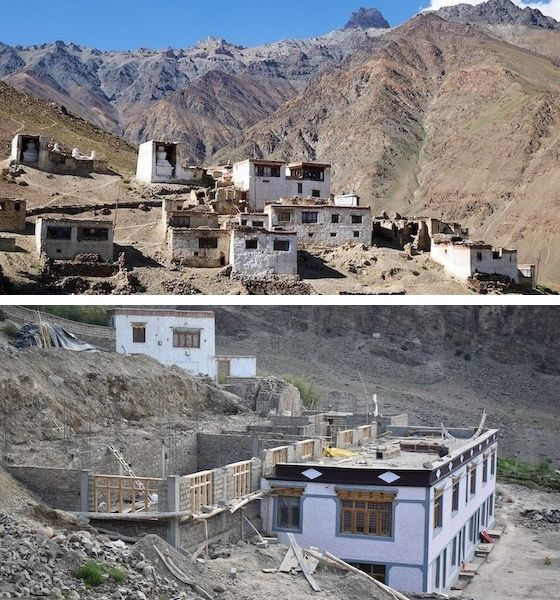
Down the hill from ancient Dorjee Zong Nunnery, a number of new buildings are being constructed. Unfortunately, the COVID-19 pandemic and lockdown mean that further construction will likely be delayed.
Unfortunately, due to the COVID-19 pandemic, there may be a problem with construction this year. Since most of the labor force comes from Nepal, they may not be able to work due to the strict guidelines imposed by every Indian state. We will continue to report back as we get fresh news.
Life in the Nunneries Under Lockdown
All the nuns and staff are fine, at the time of writing this post.
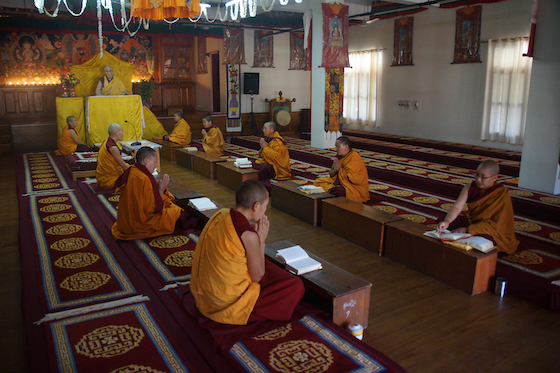
Tibetan Buddhist nuns at Dolma Ling Nunnery practice social distancing while praying. The nunnery is home to about 240 nuns. Photo courtesy of the Nuns’ Media Team.
The nuns are reciting prayers and mantras in their rooms and when they go for kora, circumambulating the nunnery complex. The nuns are spending a lot of time studying on their own.
At Dolma Ling Nunnery and Institute, the nuns shared their food rations with 100 poor village families. The local village administration asked the nunnery for help because many people cannot work and are suffering. This is a very stressful time for people who depend on work to eat, so the nuns were happy to share their food with them.
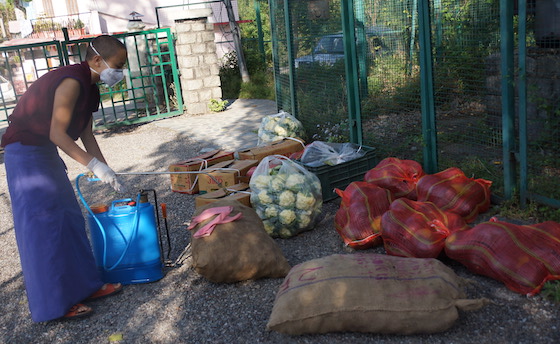
Outside the gates of Dolma Ling, a Tibetan Buddhist nun sanitizes vegetables during the coronavirus lockdown. Photo courtesy of the Nuns’ Media Team
The nuns have also made sure that the two single women employed by Dolma Ling are still being paid even though they are unable to work since the lockdown. These women were also given extra food rations.
The nunneries remain shut. The nuns are being vigilant and guard the gates, making sure no one comes in without good reason and taking sanitization precautions. Shopping for essentials is proceeding smoothly for all the nunneries.

Even under lockdown, chores continue. The nuns at Dolma Ling work together to clean the large drinking water reservoir. Photo courtesy of the Nuns’ Media Team.
In Himachal Pradesh, home to five of the nunneries, the curfew situation has eased slightly. People are allowed out for morning walks from 5:30 am to 7 am. From 8 am to 12 pm, people may go out to buy essentials and motor vehicles can travel without government passes. The government has allowed many shops to stay open during these hours.

Life under lockdown at Dolma Ling Nunnery and Institute include chores, prayers, and studying on one’s own. Photos courtesy of the Nuns’ Media Team.
The Tibetan Nuns Project is very grateful to Charles-Antoine Janssen for his generous gift of over 3,500 masks for the nuns at various nunneries.
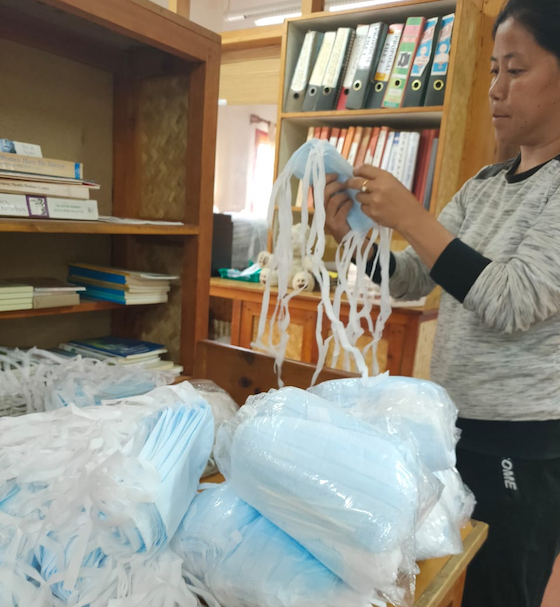
In April, Mr. Charles-Antoine Janssen, Founder and Managing Partner at Kois Invest in Mumbai, donated more than 3,500 masks to the Tibetan Nuns Project for the nuns at various nunneries.
The Tibetan Nuns Project office gave 500 masks to the Nuns’ Committee at Dolma Ling for distribution to nuns and staff and has contacted the other nunneries so that the masks can be quickly collected. The Dolma Ling nuns offered a puja gift for Charles-Antoine Janssen, his wife, and two sons.
Update on the Sherab Choeling Nuns
As we reported in April, in mid-February 44 of the nuns from Sherab Choeling travelled to the town of Hamirpur so that they could continue their philosophy classes.
Then the coronavirus lockdown happened and all classes were suspended. After lots of hard work, the nuns were able to arrange for two buses to take them and their two teachers back to Sherab Choeling. To maintain social distancing, the nuns had to sit apart, requiring more bus space that would be needed under normal circumstances.

Sherab Choeling nuns stand apart in circles at a checkpoint en route back to the nunnery. To get back home to Sherab Choeling Nunnery during the coronavirus lockdown, the nuns had to rent two big buses and sit apart from each other.
